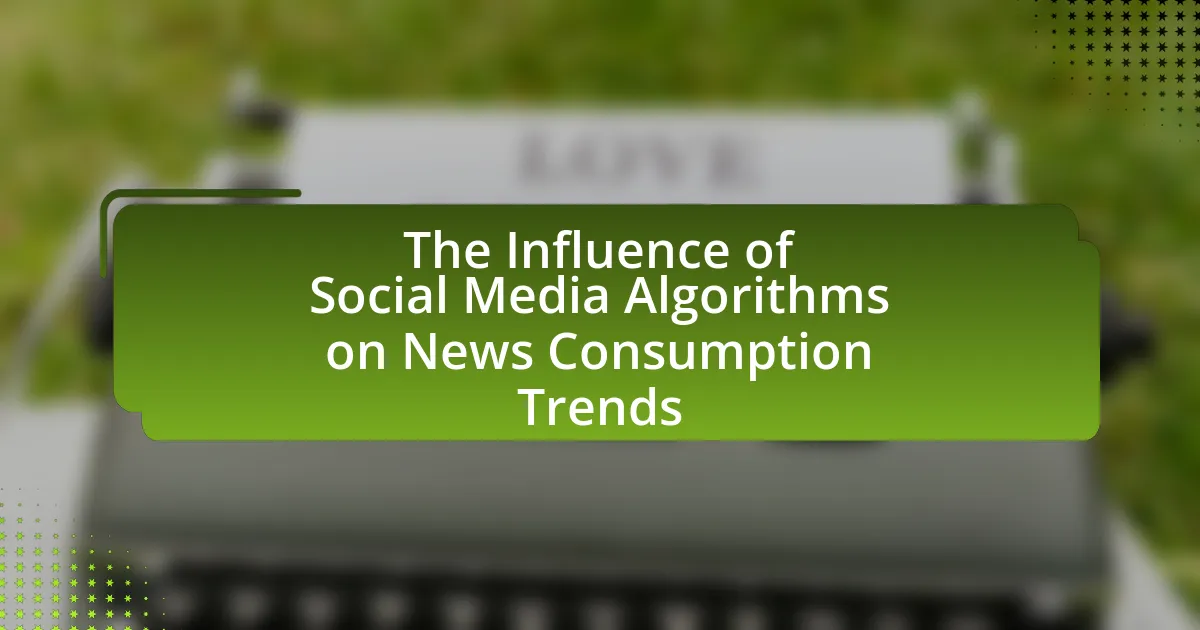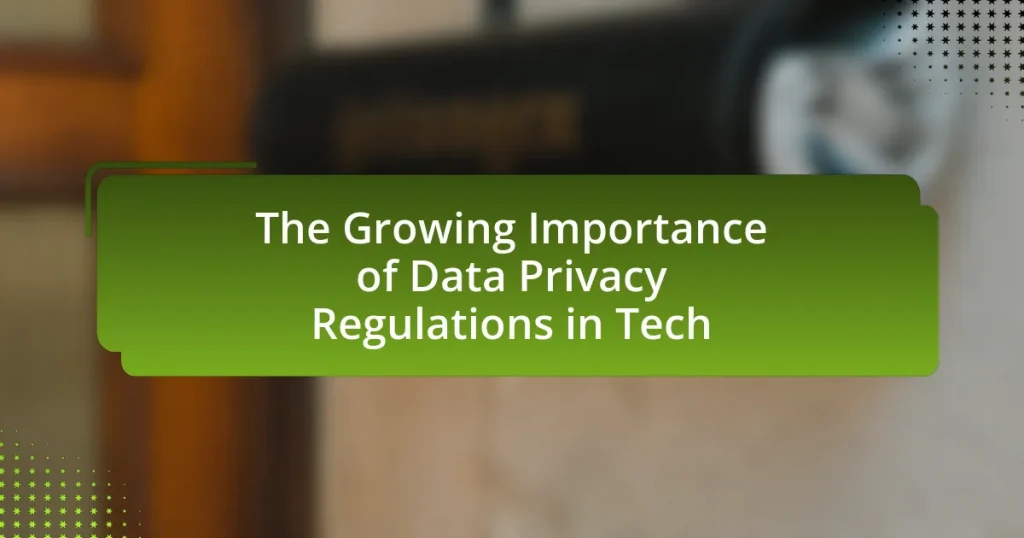The article examines the influence of social media algorithms on news consumption trends, highlighting how these algorithms curate content based on user preferences and behaviors. It discusses the mechanisms through which algorithms determine the visibility of news articles, the factors influencing their ranking, and the implications for the diversity of news sources and user perception of credibility. Additionally, the article addresses ethical considerations, including the spread of misinformation and the creation of echo chambers, while offering practical strategies for users to navigate news consumption effectively in an algorithm-driven landscape.
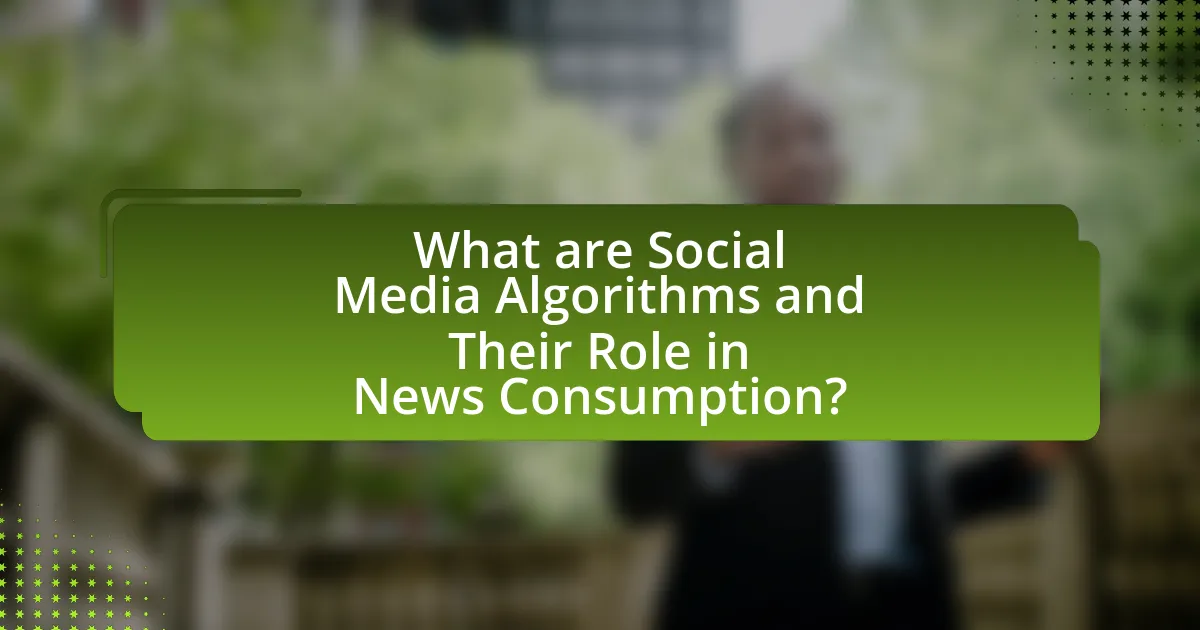
What are Social Media Algorithms and Their Role in News Consumption?
Social media algorithms are complex mathematical formulas used by platforms to determine which content is displayed to users based on their preferences and behaviors. These algorithms play a crucial role in news consumption by curating the information that users see, often prioritizing content that aligns with their interests and engagement patterns. For instance, a study by the Pew Research Center found that 62% of U.S. adults get news on social media, highlighting the significant impact of these algorithms on public access to information. By analyzing user interactions, such as likes, shares, and comments, social media algorithms can amplify certain news stories while suppressing others, thereby shaping the overall narrative and influencing public opinion.
How do social media algorithms determine what news users see?
Social media algorithms determine what news users see by analyzing user behavior, engagement patterns, and content relevance. These algorithms prioritize content that aligns with users’ interests, based on factors such as previous interactions, likes, shares, and comments. For instance, Facebook’s algorithm uses machine learning to assess the likelihood of a user engaging with a post, which influences the visibility of news articles in their feed. Research indicates that algorithms can significantly shape news consumption, as a study by the Pew Research Center found that 62% of Americans get news from social media, highlighting the impact of algorithmic curation on public information exposure.
What factors influence the ranking of news articles in social media feeds?
The ranking of news articles in social media feeds is influenced by several key factors, including user engagement, recency of the content, and relevance to the user’s interests. User engagement metrics, such as likes, shares, and comments, signal to algorithms that content is valuable, thus boosting its visibility. Recency is crucial as algorithms prioritize newer articles to keep feeds current and engaging. Additionally, algorithms analyze user behavior and preferences to determine relevance, ensuring that articles align with individual interests and past interactions. These factors collectively shape the visibility and ranking of news articles in social media environments.
How do user interactions shape algorithmic outcomes for news content?
User interactions significantly shape algorithmic outcomes for news content by influencing which articles are promoted or demoted in users’ feeds. Algorithms analyze user behaviors such as clicks, shares, comments, and time spent on articles to determine engagement levels. For instance, a study by the Pew Research Center found that 62% of Americans get news from social media, indicating that user engagement directly affects visibility and reach. Higher engagement signals to algorithms that content is relevant, leading to increased distribution, while lower engagement results in reduced visibility. This dynamic creates a feedback loop where popular content is further amplified, shaping the overall news landscape based on user preferences and interactions.
Why is understanding social media algorithms important for news consumers?
Understanding social media algorithms is crucial for news consumers because these algorithms determine the visibility and prioritization of news content in users’ feeds. By influencing what news articles are shown, algorithms can shape public perception and awareness of current events. For instance, a study by the Pew Research Center found that 62% of adults in the U.S. get news from social media, highlighting the significant role these platforms play in information dissemination. Consequently, awareness of how algorithms function enables consumers to critically evaluate the news they encounter, recognize potential biases, and seek diverse perspectives, ultimately fostering informed decision-making.
What impact do algorithms have on the diversity of news sources available?
Algorithms significantly reduce the diversity of news sources available to users. This occurs because algorithms prioritize content based on user engagement metrics, often favoring popular or sensational news over niche or diverse perspectives. Research by the Pew Research Center indicates that social media platforms like Facebook and Twitter tend to create echo chambers, where users are exposed primarily to viewpoints that align with their own, limiting exposure to a broader range of news sources. Consequently, this algorithmic filtering can lead to a homogenization of news consumption, where fewer sources dominate the information landscape, ultimately impacting public discourse and understanding of diverse issues.
How do algorithms affect the perception of news credibility among users?
Algorithms significantly influence the perception of news credibility among users by determining which content is prioritized in their feeds. These algorithms often favor sensational or emotionally charged stories, leading users to perceive such content as more credible due to its visibility and engagement metrics. Research indicates that users are more likely to trust news that appears frequently in their feeds, regardless of its actual accuracy. For instance, a study by the Pew Research Center found that 62% of social media users believe that the news they see on these platforms is credible, largely influenced by the algorithms that curate their news exposure. This reliance on algorithmically curated content can create echo chambers, where users are exposed primarily to viewpoints that reinforce their existing beliefs, further skewing their perception of credibility.
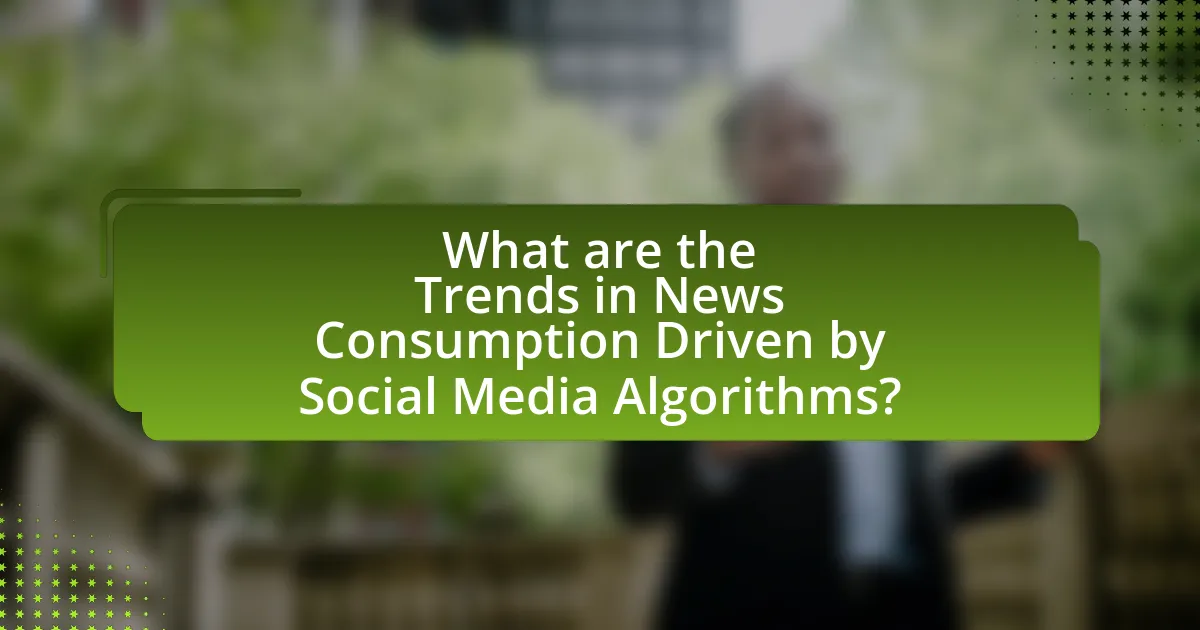
What are the Trends in News Consumption Driven by Social Media Algorithms?
Trends in news consumption driven by social media algorithms include increased personalization, the rise of short-form content, and the prioritization of sensationalism. Personalization occurs as algorithms analyze user behavior to curate news feeds tailored to individual preferences, leading to echo chambers where users are exposed primarily to viewpoints that reinforce their beliefs. The rise of short-form content is evident as platforms like TikTok and Instagram promote bite-sized news updates, catering to users’ decreasing attention spans. Sensationalism is prioritized as algorithms favor emotionally charged headlines and stories that generate higher engagement, often at the expense of factual accuracy. Research by the Pew Research Center indicates that 55% of U.S. adults get news from social media, highlighting the significant impact of these algorithms on public information consumption.
How have social media algorithms changed the way news is consumed over time?
Social media algorithms have significantly altered news consumption by prioritizing personalized content over chronological feeds. These algorithms analyze user behavior, such as likes and shares, to curate news that aligns with individual preferences, leading to echo chambers where users are exposed primarily to viewpoints that reinforce their beliefs. Research from the Pew Research Center indicates that 62% of Americans get news from social media, highlighting the shift from traditional news sources to algorithm-driven platforms. This change has resulted in a decline in exposure to diverse perspectives, as users increasingly receive news tailored to their interests rather than a broad spectrum of information.
What shifts in user behavior can be attributed to algorithmic changes?
Algorithmic changes have led to significant shifts in user behavior, particularly in how individuals consume news on social media platforms. Users increasingly engage with content that is personalized to their preferences, resulting in a tendency to favor sensational or emotionally charged news articles over balanced reporting. Research by the Pew Research Center indicates that 62% of social media users have changed their news consumption habits due to algorithmic recommendations, often leading to echo chambers where users are exposed primarily to viewpoints that reinforce their existing beliefs. This shift not only alters the diversity of information users encounter but also impacts their overall understanding of current events, as algorithms prioritize engagement metrics over factual accuracy.
How do demographic factors influence news consumption trends on social media?
Demographic factors significantly influence news consumption trends on social media by shaping preferences and behaviors across different age groups, genders, and educational backgrounds. For instance, younger users, particularly those aged 18-29, tend to consume news more frequently on platforms like Instagram and TikTok, while older demographics, such as those over 50, often prefer Facebook and traditional news websites. Research from the Pew Research Center indicates that 53% of adults aged 18-29 get their news from social media, compared to only 23% of those aged 50 and older. Additionally, gender differences emerge, with women more likely to engage with news content that focuses on social issues, while men may gravitate towards sports and politics. Educational attainment also plays a role; individuals with higher education levels are more likely to seek out diverse news sources and critically evaluate the information presented. These demographic trends highlight how social media algorithms tailor content to user preferences, thereby influencing overall news consumption patterns.
What are the implications of these trends for traditional news outlets?
The implications of social media algorithms on traditional news outlets include a significant decline in audience engagement and revenue. As algorithms prioritize personalized content, traditional news outlets face challenges in reaching broader audiences, leading to reduced visibility and diminished advertising income. For instance, a Pew Research Center study found that 62% of Americans get news from social media, indicating a shift away from traditional platforms. This trend forces traditional news outlets to adapt their strategies, focusing on digital presence and audience interaction to remain relevant in a rapidly changing media landscape.
How are traditional media adapting to the influence of social media algorithms?
Traditional media are adapting to the influence of social media algorithms by integrating data analytics to tailor content for audience engagement. This adaptation includes employing audience insights derived from social media platforms to inform editorial decisions, ensuring that content aligns with trending topics and user preferences. For instance, many news organizations now utilize tools that analyze social media interactions to identify what stories resonate most with audiences, leading to increased viewership and engagement. Additionally, traditional media outlets are enhancing their online presence and utilizing social media for distribution, which allows them to reach wider audiences and compete effectively with digital-native platforms. This shift is evidenced by the fact that over 60% of adults in the U.S. now get news from social media, prompting traditional outlets to prioritize social media strategies in their operations.
What challenges do traditional news organizations face in the algorithm-driven landscape?
Traditional news organizations face significant challenges in the algorithm-driven landscape, primarily due to the shift in audience engagement and content distribution. Algorithms prioritize content based on user preferences and engagement metrics, often sidelining traditional news sources in favor of sensational or viral content. This shift has led to decreased visibility for reputable journalism, as platforms like Facebook and Twitter favor posts that generate higher interaction rates, regardless of their factual accuracy.
Moreover, traditional news organizations struggle with adapting their business models to monetize content effectively in an environment dominated by free social media platforms. According to a Pew Research Center study, 62% of Americans get news from social media, which often leads to a reliance on advertising revenue that is increasingly difficult to secure. This reliance on algorithms also results in a homogenization of news content, as organizations may feel pressured to produce clickbait-style articles to compete for attention, undermining journalistic integrity.
In summary, the algorithm-driven landscape challenges traditional news organizations by diminishing their reach, altering revenue models, and pressuring them to compromise on content quality.
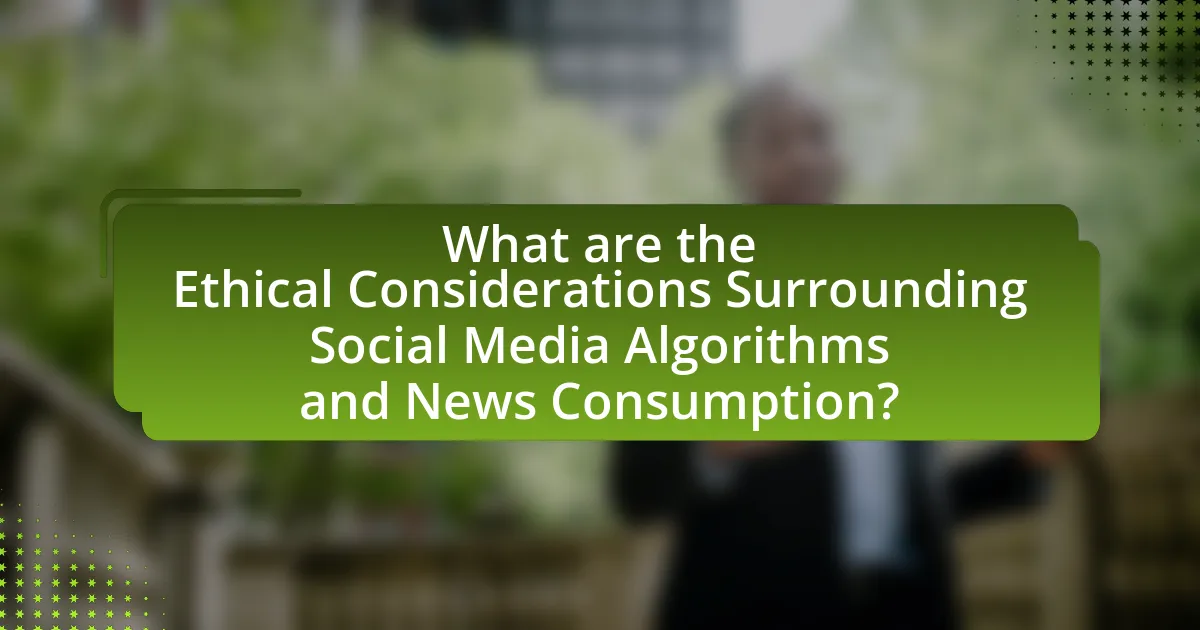
What are the Ethical Considerations Surrounding Social Media Algorithms and News Consumption?
The ethical considerations surrounding social media algorithms and news consumption include issues of bias, misinformation, and user autonomy. Algorithms often prioritize engagement over accuracy, leading to the amplification of sensational or misleading content, which can distort public perception and understanding of important issues. For instance, a study by the Pew Research Center found that 64% of Americans believe that social media platforms have a mostly negative effect on the way things are going in the country today, highlighting concerns about the impact of algorithm-driven content curation on societal discourse. Additionally, the lack of transparency in how these algorithms operate raises questions about accountability and the potential for manipulation, as users may unknowingly be subjected to tailored content that reinforces their existing beliefs, thereby limiting exposure to diverse viewpoints.
How do social media algorithms contribute to misinformation and echo chambers?
Social media algorithms contribute to misinformation and echo chambers by prioritizing content that aligns with users’ existing beliefs and preferences, thereby limiting exposure to diverse viewpoints. These algorithms analyze user behavior, such as likes and shares, to curate feeds that reinforce personal biases, which can lead to the spread of false information. A study by the Pew Research Center found that 64% of Americans believe that social media platforms have a significant role in the spread of misinformation, highlighting the impact of algorithmic design on public perception. Additionally, echo chambers are formed as users engage with similar content, creating a feedback loop that further entrenches misinformation and reduces critical discourse.
What role do algorithms play in the spread of fake news on social media?
Algorithms significantly contribute to the spread of fake news on social media by prioritizing content that generates high engagement, often regardless of its accuracy. These algorithms analyze user interactions, such as likes, shares, and comments, to promote sensational or emotionally charged content, which frequently includes misinformation. Research by the Massachusetts Institute of Technology found that false news stories spread six times faster than true stories on Twitter, largely due to algorithmic amplification of engaging content. This prioritization leads to a feedback loop where users are repeatedly exposed to misleading information, reinforcing false narratives and shaping public perception.
How can users identify and mitigate the effects of biased algorithms?
Users can identify and mitigate the effects of biased algorithms by actively monitoring the content they consume and employing critical thinking skills. By analyzing the diversity of sources and perspectives presented in their feeds, users can recognize patterns of bias, such as the prevalence of certain viewpoints over others. Research indicates that algorithms often prioritize engagement over accuracy, leading to echo chambers that reinforce existing beliefs (Pariser, 2011). To counteract this, users should diversify their information sources, seek out fact-checking resources, and adjust their algorithmic settings where possible to promote a broader range of content. Engaging with platforms that prioritize transparency about their algorithms can also help users understand how their data influences content delivery, thereby reducing the impact of bias.
What responsibilities do social media platforms have regarding news content?
Social media platforms have the responsibility to ensure the accuracy and reliability of news content shared on their sites. This includes implementing measures to prevent the spread of misinformation and disinformation, as evidenced by the rise of fact-checking initiatives and content moderation policies adopted by major platforms like Facebook and Twitter. According to a 2020 Pew Research Center study, 53% of U.S. adults say they often encounter made-up news, highlighting the need for platforms to actively manage the quality of information disseminated. Additionally, social media companies are tasked with promoting transparency in their algorithms, which can significantly influence what news users see, thereby shaping public perception and discourse.
How can social media companies improve transparency in their algorithms?
Social media companies can improve transparency in their algorithms by implementing clear disclosure policies that explain how content is prioritized and filtered. This can include publishing detailed documentation on algorithmic processes, providing users with insights into why specific content is shown to them, and allowing users to access and understand their data usage. For instance, Facebook has initiated transparency measures by releasing its algorithm guidelines and offering users the ability to see why certain posts appear in their feeds. Such actions can enhance user trust and accountability, as evidenced by studies showing that transparency can lead to increased user satisfaction and engagement.
What measures can be taken to ensure fair news representation on social media?
To ensure fair news representation on social media, platforms should implement transparent algorithms that prioritize diverse viewpoints and factual accuracy. Transparency in algorithms allows users to understand how content is curated, reducing bias in news representation. Research indicates that algorithmic transparency can lead to a more balanced dissemination of information, as seen in studies by the Pew Research Center, which found that users exposed to a variety of news sources are more likely to engage with differing perspectives. Additionally, social media companies can establish partnerships with independent fact-checkers to verify news content, thereby enhancing credibility and reducing misinformation.
What practical strategies can users employ to navigate news consumption on social media?
Users can employ several practical strategies to navigate news consumption on social media effectively. First, they should diversify their news sources by following a range of reputable outlets to avoid echo chambers and biased information. Research indicates that exposure to diverse viewpoints enhances critical thinking and reduces misinformation. Second, users can utilize fact-checking websites, such as Snopes or FactCheck.org, to verify the accuracy of news stories before sharing or believing them. Studies show that misinformation spreads rapidly on social media, making verification crucial. Third, users should adjust their social media algorithms by actively engaging with content that reflects their interests and values, which can help curate a more balanced news feed. Lastly, setting specific time limits for social media use can prevent information overload and promote more mindful consumption of news. These strategies collectively empower users to make informed decisions and mitigate the influence of social media algorithms on their news consumption.
